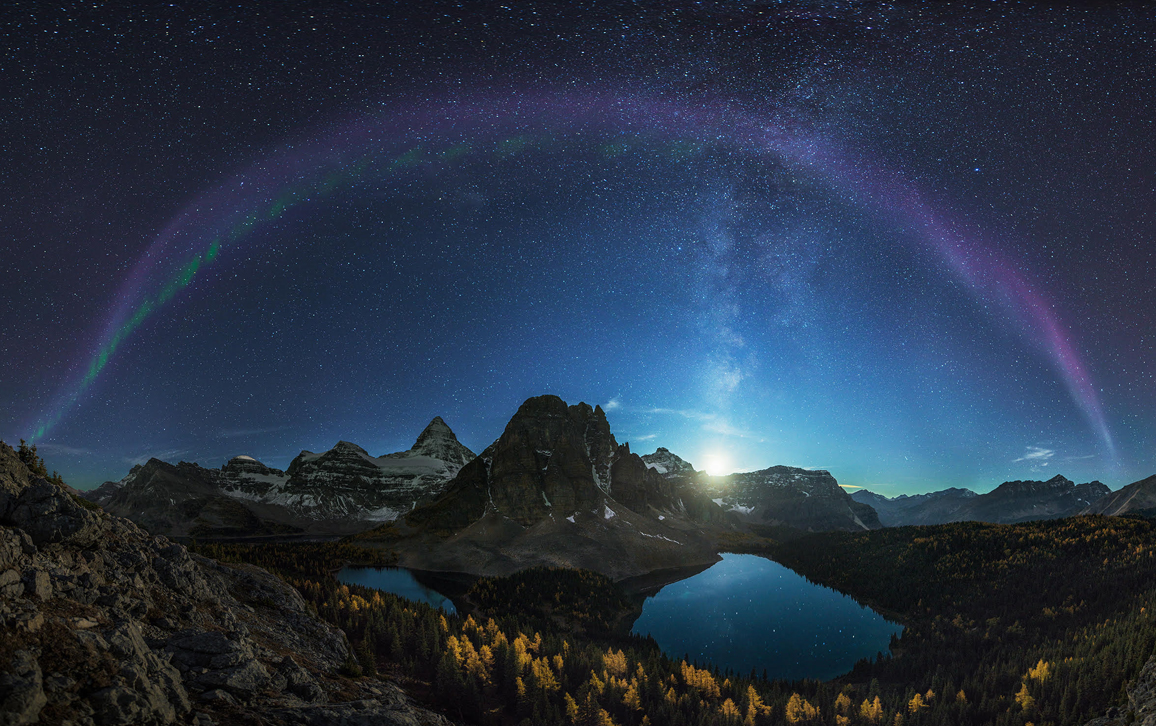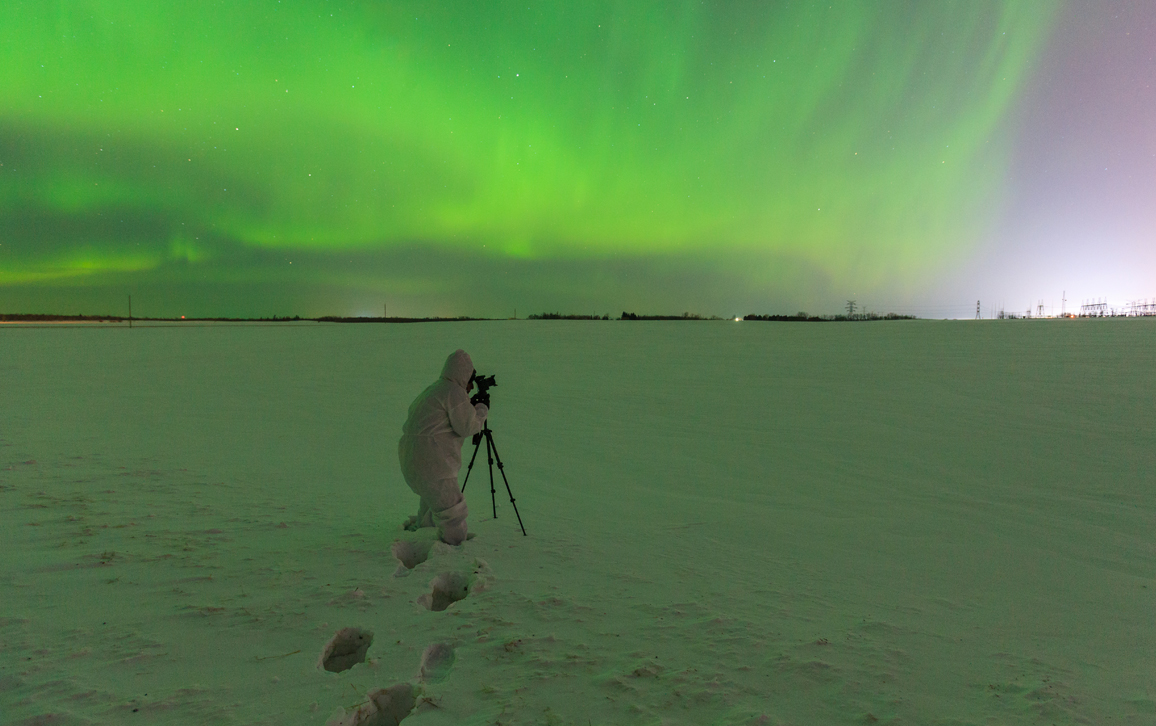STEVE and the Citizen Scientists
By Elizabeth MacDonald
Night-watching enthusiasts identify a new type of aurora
Night-watching enthusiasts identify a new type of aurora

Public participation in research has yielded unanticipated discoveries in many fields, but probably no recent discovery in astronomy and physics owes more to such citizen scientists than the identification of the one-of-a-kind aurora known as STEVE. A display of purple and green lights running east to west, STEVE appears relatively high up in the nighttime sky, for about an hour at a time. People who’ve been able to photograph it, from locations as far-flung as Tasmania, Michigan, and Scotland, and especially those in the area around Calgary, Alberta, report that the purple part of the aurora resembles a ribbon, with the green part appearing in a series of lines like a picket fence—an unforgettable sight.
The visible structure of STEVE has been documented by the aurora- chasing public for a long time, but only in the past few years have researchers started to identify the physical processes underlying this unusual sight. It seems that STEVE’s visible light occurs along with a subauroral ion drift (SAID), a strong westward flow of charged particles that’s still not completely understood.

Jun Wang
To those who are unfamiliar with it, this phenomenon looks like nothing more remarkable than a narrow, wavy light in the nighttime sky. Being colorless to the naked eye, STEVE had attracted little attention until the skilled camera work of dedicated citizen scientists revealed its true colors. Then, fortuitously, one of the European Space Agency’s satellites for monitoring space weather happened to pass through a sector of the sky while STEVE was on full display, observed on the ground by citizen scientists and by the scientific cameras of the University of Calgary. The satellite, revealing the characteristic flow and heating of a SAID, supplied a major clue to explain what makes STEVE so unusual.
Many early photographs of STEVE were posted on the internet by the amateur sky watchers known as the Alberta Aurora Chasers. In addition, this group met with local scientists to exchange observations and theories about what they had seen. When at length they were convinced that the term “proton arc,” which they had been using for this phenomenon, was not scientifically accurate, the Alberta Aurora Chasers decided to give it the placeholder name “Steve”—a joke alluding to a mysterious hedge, in the 2006 children’s film Over the Hedge, which frightens some woodland creatures when they come upon it suddenly in their environment.
Professional researchers eventually welcomed the discovery. In a recent article in The Atlantic, Larry Lyons, a space physicist at the University of California, Los Angeles, said, “It is truly exciting to us, as aurora scientists, that there is a group of amateurs out there who enjoy the aurora so much that they could put together something that is this new to us.” In fact, because STEVE is the first aurora known to be accompanied by subauroral ion drift, it may represent an entirely new species of hybrid flow-driven aurora. Although researchers have been able to determine that SAIDs come about as a result of competing plasma processes occurring at the same time (increased ionospheric conductance at high latitudes and very low conductance at lower latitudes), we have not yet been able to model them with enough detail to make accurate predictions about them. We have, however, managed to adhere to academic conventions, while also giving a nod to the citizen scientists, by coming up with a phrase—Strong Thermal Emission Velocity Enhancement—that converts to the acronym STEVE.
STEVE was novel, also, in the way that it came to the attention of researchers: through citizen science, in a type of nonlinear advance called disruptive innovation. Although disruptive innovation is tricky to define in the abstract, most instances of it share a couple of characteristics. They tend to originate outside the traditional realm, and although the results they produce may not initially meet established standards, they can improve very rapidly, to the point of setting new standards.
The Aurorasaurus citizen science project, which I founded in 2013 with half a dozen colleagues and support from the National Science Foundation, exemplifies these traits as well. First launched as a small online platform for aurora lovers, this website has grown into a worldwide collaboration and data repository. Now, encouraged both by word of mouth and by extensive press coverage—including, of course, many stunning images—more and more people are observing and reporting auroras for science. Everyone who registers at the website, Aurorasaurus.org, can receive an alert when an aurora has been sighted nearby, and the data these enthusiasts gather with their smartphones is a valuable complement to the observations made by professional researchers with state-of-the-art equipment.

Hugo Sanchez; Krista Trinder/NASA Goddard Space Flight Center
Aurora enthusiasts and citizen scientists are a more diverse group than your typical astrophysics department. They belong to a tradition that goes back at least to the 19th century, when a dedicated amateur scientist named Wilson Bentley watched the skies from his farm in Vermont, and that today includes a group of new parents in Alaska who are awake at night to care for their infants and share news about the latest aurora sighting. The aim of the Aurorasaurus project is to help all of these people increase their chances of spotting aurora; thus even negative data, such as reports of fruitless observation attempts, can be useful to others.
We need people from all walks of life to see themselves as part of the scientific endeavor, just as we need professional researchers to accept and respect their contributions as real science. In the future, will projects be linked to our social media and personal sensor networks? Will a clear pathway be established that allows school-age enthusiasts to follow their passion for science into higher education? My colleagues and I are excited to see these possibilities starting to take shape. As we say in the paper we published earlier this year in Science Advances, our hope is that “this example can help change the nature of scientific engagement between the scientific community and citizen scientists and move communication from one way to two way, with curiosity transitioning to participation and finally to stewardship.”
With all the vastness of new data arrays available to us, human input still holds unique value.
With all the vastness of new data arrays available to us, human input still holds unique value. The friendly name “Steve,” the striking photographs that got people excited about an obscure phenomenon, and the enthusiasm of the Alberta Aurora Chasers were all critical in pushing this science forward. Ultimately, I believe, citizen science data will help propel us to new heights through disruptive innovation. One of the things I appreciate most about citizen science is its egalitarian outlook, which provides a mechanism for teaching science how to evolve and diversify.
On a recent night outside Banff, Alberta, I gathered a car full of scientists to look up at the sky. Although the night was mostly clear, with just a faint green aurora glowing on the northern horizon, we saw an unmistakable silver ribbon moving overhead. As we took in the unexpected treat of a STEVE sighting, thoughts of wonder and gratitude filled our heads—along with the nagging question, “How did we overlook this for so long?” It took the power of disruptive innovation, via citizen science, to open up this siloed field to a major new discovery. I have no doubt there are many more STEVEs, in many different siloed fields, yet to be discovered.
Click "American Scientist" to access home page
American Scientist Comments and Discussion
To discuss our articles or comment on them, please share them and tag American Scientist on social media platforms. Here are links to our profiles on Twitter, Facebook, and LinkedIn.
If we re-share your post, we will moderate comments/discussion following our comments policy.